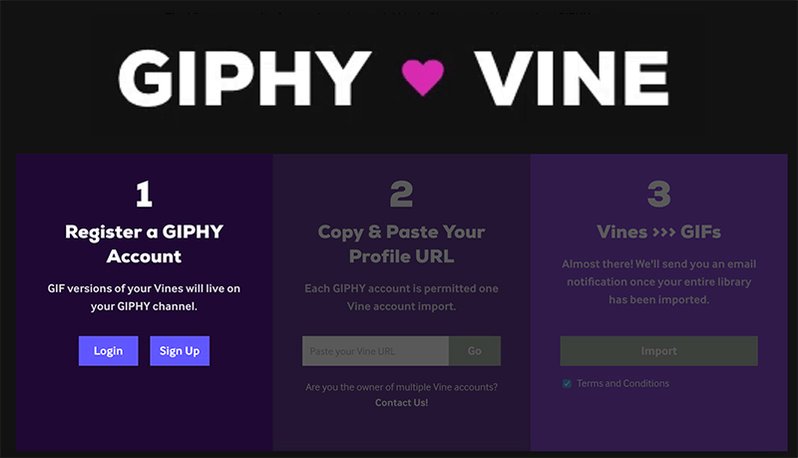Twitter’s six-second looping video app, Vine, is going to be shutting down soon. The reason is partially that Twitter is struggling to be in the black with their revenue, but also that Twitter is still trying to find itself. Additionally, other companies jumped into the same video space and moved ahead of Vine in popularity, such as Instagram, Snapchat, and Giphy.
Vine was bought by Twitter in 2012 and was initially an online hit. However, with Vine’s headquarters in New York and Twitter’s in California, this apparently caused a disconnect. They also struggled to keep the leadership role at Vine consistent, with people leaving to take other positions, which didn’t help the situation. In this article by The Verge, more detail about the situation are explained:
Why Vine died – The Verge
The thing about Vine becoming the internet’s premier tool for making short-form videos is that it happened almost completely by accident. Its founders had envisioned their tool for making 6-second clips as a way to help people capture casual moments in their lives and share them with friends. It waspart of their pitch to Twitter, which bought the company for a reported $30 million in October 2012, seeing it as a near-perfect video analog to its flagship app’s short-form text posts.And yet even before the app launched, users had taken the 6-second constraint as a creative challenge. Something about that loop — the way a Vine endlessly rewound itself after completing, like a GIF with audio — encouraged people to put the app to strange uses. “It was surprising,” said Dom Hofmann, who founded Vine with Rus Yusupov and Colin Kroll four months before Twitter bought it. “Our original beta had something like 10 or 15 people on it, and even with that small group we started to see experimentation pretty early on.”Within weeks, it appeared that Vine probably would never become the everyday video sharing tool its founders had envisioned. Instead it became something wilder — and much more culturally interesting. “It became pretty clear as soon after we launched,” Hofmann said. “Watching the community and the tool push on each other was exciting and unreal, and almost immediately it became clear that Vine’s culture was going to shift towards creativity and experimentation.”On Thursday, the experimentation came to an end. With its own future increasingly uncertain, Twitter said it would shut down Vine’s mobile app some time in the next few months. And while existing Vines will remain on the web, a media format that had become beloved for its versatility now appears headed the way of Betamax.Read the original post here: Why Vine died – The Verge
Giphy, another looping video app, is extremely popular right now. It has a lot of similarities to Vine, and is now allowing Vine users to import their videos to their service. Ironically, this post is from Giphy’s Twitter account:
So what are the differences between Vine and Giphy? They both have difficulty monetizing their product, but Giphy is valued at $600 million dollars. This type of platform with short looping video clips that are entertaining and invoke emotions, like a moving emoticon, might be the future of media. Could it have something to do with our attention span? Probably so, but this article from Fortune explains further why the company is valued so high:
Animated GIF Company Giphy Has No Revenue But Is Worth $600 Million
Whether it’s on Twitter, Facebook, or in your company’s Slack inter-office chat threads, you’ve probably seen hundreds of them—animated GIFs of Donald Trump making faces, or of popular Internet “memes,” like the little girl doing the rock salute while four-wheel drifting in her toy Corvette.
These little mini-clips may be fun, but does that justify giving one of the companies that create them a market value of $600 million? By way of comparison, that’s more than twice what Amazon CEO Jeff Bezos paid for the Washington Post.Giphy, which was created in 2013 as part of the New York-based venture fund/incubator Betaworks, got this valuation by raising a Series D funding round of $75 million from a series of venture capital investors. That doubled the amount the company has raised so far, and coincidentally also doubled its valuation to $600 million.If you’re wondering what Giphy’s valuation works out to as a multiple of revenue, the answer is that it’s almost infinite — because the company doesn’t really have any revenue to speak of.So then why should this business be worth $600 million? Giphy and its investors argue that it is essentially a model for a new kind of media company. It creates bite-sized pieces of video that can go incredibly viral in a matter of minutes, whether it’s about the election campaign or a popular TV show.Read the full post here: Animated GIF Company Giphy Has No Revenue But Is Worth $600 Million
A GIF, also known as graphic interchange format, is an image file that supports both still shots and animated videos, and it is where Giphy got their name. The image below is an example of a GIF from Giphy. You can see that it just keeps looping the same clip over and over.
I also thought the GIF was somewhat of a statement for how hard it is to monetize these types of platforms…the money is there but you can’t quite grasp it. Media platforms have their work cut out for them as far as discovering the best way to earn revenue through these creative communication tools. The battle for catching the viewers’ attention and dollars will prove who is the most imaginative entrepreneur.
The post was originally seen on S&S Pro Services Blog
The post was originally seen on S&S Pro Services Blog





No comments:
Post a Comment